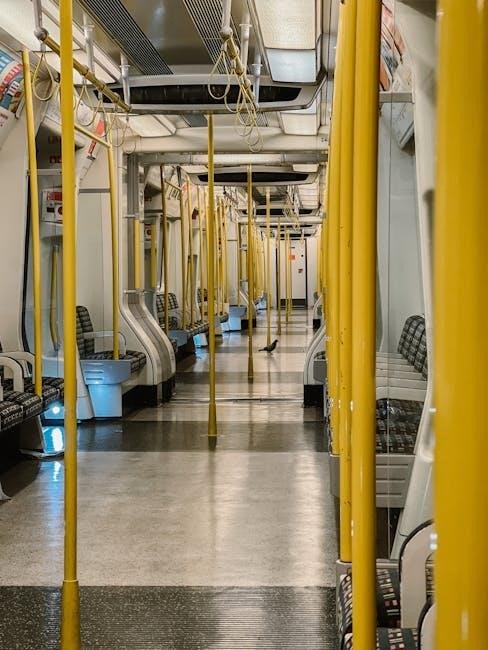
The BOSS RC-1 Loop Station is a versatile pedal-type recorder designed for guitarists and bassists, enabling audio phrase recording and playback with foot control;
1.1 What is the BOSS RC-1?
The BOSS RC-1 is a compact, pedal-type loop station designed for guitarists and bassists to record and playback audio phrases in real-time. It allows musicians to create layered sounds and loops effortlessly, making it ideal for live performances and practice sessions. With its robust construction and user-friendly interface, the RC-1 is a popular choice among musicians seeking a reliable looping solution. It supports single-track recording and overdubbing, enabling artists to build complex sounds step-by-step. The device features nominal input and output levels of -20 dBu, input impedance of 1 MΩ, and output impedance of 1 kΩ, ensuring high-quality audio processing and compatibility with a wide range of musical gear.
1.2 Purpose and Target Audience
The BOSS RC-1 Loop Station is designed to empower musicians with real-time audio recording and playback capabilities, making it an essential tool for practice, composition, and live performances. Its primary purpose is to enable guitarists and bassists to create and layer loops seamlessly, enhancing their creative expression and musical versatility.

The target audience includes professional musicians, hobbyists, and educators seeking a reliable looping solution. It is ideal for solo artists who want to build complex sounds and for band members looking to add depth to their performances. The RC-1’s intuitive design makes it accessible to musicians of all skill levels, from beginners exploring looping for the first time to experienced players seeking a robust, high-quality looping pedal.

Key Features of the BOSS RC-1
The BOSS RC-1 offers 24-bit hi-fi sound quality, a non-slip pedal surface, and intuitive controls for seamless recording and playback of audio loops, enhancing musical creativity.
2.1 Overview of Features
The BOSS RC-1 Loop Station is equipped with a robust set of features tailored for musicians. It offers 24-bit hi-fi audio recording, ensuring crisp and clear sound quality. The pedal-type design provides hands-free operation, making it ideal for live performances and practice sessions. With its intuitive interface, users can easily navigate between recording, overdubbing, and playback modes. The RC-1 also features a non-slip surface for reliable foot control, reducing the risk of accidents during use. Additionally, it supports external power supply options, providing flexibility for different setups. These features collectively make the RC-1 a powerful tool for guitarists and bassists seeking to expand their creative possibilities through looping.
2.2 Unique Selling Points
The BOSS RC-1 Loop Station stands out for its exceptional audio quality, offering 24-bit hi-fi recording and playback. Its compact, pedal-type design allows for seamless foot control, making it ideal for live performances. With up to 3 hours of recording time, the RC-1 provides ample space for creating intricate loops. The unit is also highly durable, featuring a robust construction and non-slip pedal surface for reliable use. Its intuitive operation makes it accessible to musicians of all skill levels, while its versatility supports both guitar and bass players. These features combined make the RC-1 a standout choice for artists seeking a reliable and creative looping solution.

Basic Operation of the RC-1
The BOSS RC-1 operates via a single pedal for recording, overdubbing, and playback. Press once to record and twice to play. The Level knob adjusts loop volume.
3.1 Pedal Functions and Controls
The BOSS RC-1 features a straightforward design with a single pedal for recording, overdubbing, and playback. Pressing the pedal once starts recording, while pressing it twice begins playback. The pedal also allows for overdubbing by stacking layers of sound in real-time. A dedicated Level knob adjusts the overall volume of the loop, ensuring seamless integration with your rig. The pedal’s non-slip surface provides sturdy control during performances, while the LED indicator offers visual feedback for operation modes. These intuitive controls make the RC-1 easy to use, even for beginners, while still offering depth for creative experimentation.
3.2 LED Indicators and Their Meanings
The BOSS RC-1 Loop Station features a clear LED indicator system to guide operation. A green LED signifies recording mode, while a red LED indicates playback. When overdubbing, the LED flashes red, showing the device is layering sounds. A yellow LED appears when memory is nearly full, alerting you to save or clear loops. Additionally, the LED flashes twice if memory is exhausted, requiring you to free up space. These visual cues ensure intuitive control, allowing performers to focus on their music without constant menu navigation. The LED system provides real-time feedback, making it easy to track the loop station’s status during live or practice sessions.

Recording Techniques with the RC-1
The BOSS RC-1 supports single-track recording and overdubbing, allowing users to capture and layer audio phrases seamlessly. This versatility enables musicians to craft intricate loops and layered sounds creatively.
4.1 Single Track Recording

Single track recording on the BOSS RC-1 is a straightforward process that allows users to capture a lone audio phrase. By pressing the pedal, musicians can record a loop and play it back instantly. This mode is ideal for creating simple, foundational loops or practicing phrases without additional layers. The RC-1 ensures high-quality audio capture, making it perfect for guitarists and bassists seeking to build their performances from the ground up. With its intuitive interface, single track recording is a great starting point for both beginners and experienced players looking to refine their sound before adding complexity through overdubbing.
4.2 Overdubbing: Layering Sounds
Overdubbing on the BOSS RC-1 enables musicians to layer sounds, creating rich and complex compositions. After recording a base loop in single-track mode, press the pedal again to enter overdub mode. This allows you to add additional layers of sound over the existing loop. Each press of the pedal toggles between recording and playback, making it easy to build intricate arrangements. Overdubbing is perfect for adding harmonies, rhythms, or textures, giving performers the ability to craft dynamic and engaging live performances. The RC-1’s intuitive design ensures that layering sounds is both fun and creatively rewarding, making it an essential tool for both practice and performance.

Playback and Editing Capabilities
The BOSS RC-1 offers essential playback and editing features, allowing users to control loop volumes and adjust playback levels for seamless integration into live performances and recordings.
5.1 Basic Playback Functions
The BOSS RC-1 Loop Station provides intuitive playback controls, allowing users to start, stop, and rewind loops effortlessly. The pedal operation enables seamless control during live performances, ensuring smooth transitions between playback and recording modes. Once a loop is recorded, pressing the pedal once starts playback, while pressing it again stops the loop. The LED indicator changes color to indicate playback status, providing clear visual feedback. Additionally, the RC-1 allows for immediate playback of recorded phrases, making it ideal for live jam sessions and creative experimentation. These functions ensure that users can focus on their music without unnecessary complexity.
5.2 Loop Editing Techniques
The BOSS RC-1 Loop Station offers essential editing features to refine your loops. Users can easily undo or redo the last recorded phrase, allowing for quick corrections without losing previous work. The loop volume can be adjusted to balance layers, ensuring a polished sound. Additionally, the RC-1 allows for tempo adjustments, enabling synchronization with external devices or metronomes. These editing techniques enhance creativity and precision, making it easier to craft professional-sounding loops. The LED indicators provide visual feedback, guiding users through the editing process. With these tools, musicians can fine-tune their loops and achieve the desired sonic results, making the RC-1 a versatile tool for live performances and studio sessions.

Technical Specifications of the RC-1
Nominal input level: -20 dBu, input impedance: 1 MΩ, nominal output level: -20 dBu, output impedance: 1 kΩ, recommended load impedance: 1 kΩ.
6.1 Nominal Input and Output Levels
The BOSS RC-1 Loop Station features a nominal input level of -20 dBu and a nominal output level of -20 dBu, ensuring consistent audio signal transmission. The input impedance is 1 MΩ, while the output impedance is 1 kΩ, which is suitable for connecting to a wide range of musical equipment. These specifications ensure that the RC-1 can handle both high and low impedance devices effectively, maintaining signal integrity and minimizing noise interference. The recommended load impedance for optimal performance is 1 kΩ, allowing the unit to operate within its designed parameters and deliver reliable audio reproduction. These technical details make the RC-1 a versatile tool for guitarists and bassists seeking high-quality looping capabilities.
6.2 Impedance and Load Considerations
The BOSS RC-1 Loop Station is designed with specific impedance and load considerations to ensure optimal performance. The input impedance is 1 MΩ, providing a high input resistance that prevents loading of the guitar’s pickups, ensuring a clear and unaffected tone. The output impedance is 1 kΩ, which is suitable for driving long cables and various types of equipment without signal degradation. The recommended load impedance of 1 kΩ ensures that the RC-1 can deliver its full potential without distortion or loss of signal quality. Proper impedance matching is crucial for maintaining the integrity of the audio signal, and the RC-1’s design ensures compatibility with a wide range of musical gear, making it a reliable choice for both live performances and studio recordings.
Connectivity and Setup
The BOSS RC-1 Loop Station connects easily to amplifiers and other gear via its input and output jacks, ensuring seamless integration into your musical setup.
7.1 Connecting to Amplifiers and Other Gear
To connect the BOSS RC-1 Loop Station to an amplifier, use a standard 1/4-inch guitar cable. Plug one end into the RC-1’s output jack and the other into your amp’s input. For integrating with additional gear like effects pedals or mixers, use the RC-1’s input and output jacks to route your signal effectively. Ensure proper impedance matching to maintain sound quality. This setup allows for flexible signal routing, making the RC-1 a versatile tool in live and studio settings. Always use high-quality cables to prevent signal loss or interference.
7.2 Power Supply Options and Requirements
The BOSS RC-1 Loop Station requires a 9V DC power supply, which can be provided via a battery or an AC adapter. For battery operation, use a 9V alkaline battery, ensuring up to 4.5 hours of continuous use. To use an AC adapter, connect a BOSS-approved 9V DC adapter with a center-negative polarity. Avoid using non-recommended adapters to prevent damage. The RC-1 also features power management capabilities, automatically turning off after 25 minutes of inactivity to conserve battery life. Always ensure the power supply matches the specified requirements to maintain optimal performance and prevent potential damage to the unit.